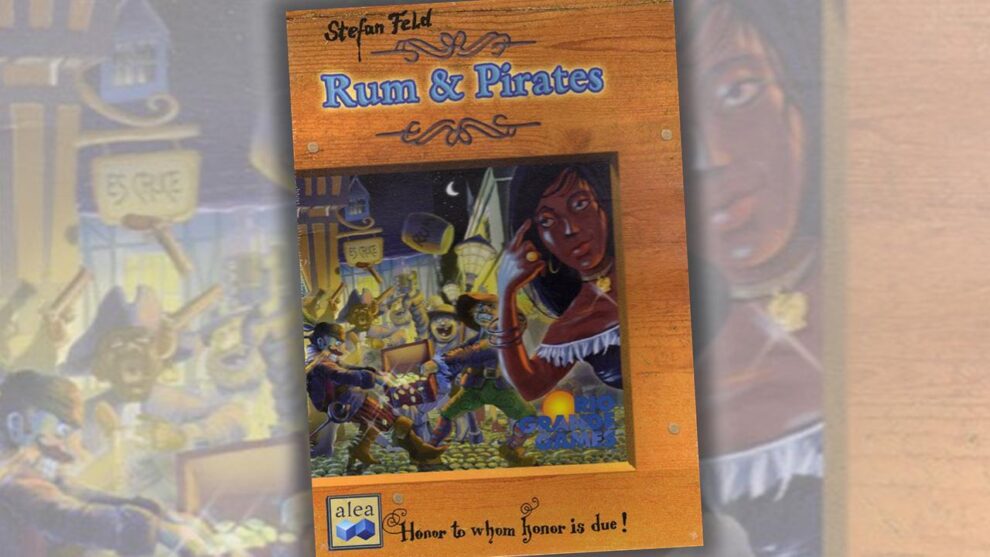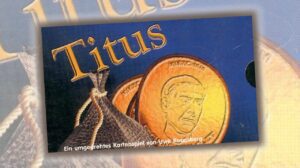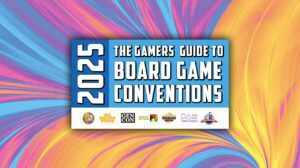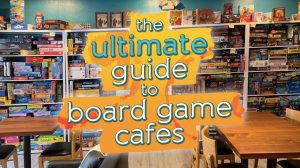Hello and welcome to ‘Focused on Feld’. In my Focused on Feld series of reviews, I am working my way through Stefan Feld’s entire catalogue. Over the years, I have hunted down and collected every title he has ever put out. Needless to say, I’m a fan of his work. I’m such a fan, in fact, that when I noticed there were no active Stefan Feld fan groups on Facebook, I created one of my own.
Today we’re going to talk about 2006’s Rum & Pirates, his 2nd game. Rum & Pirates is notable as Feld’s first ever collaboration with publisher alea.
In Rum & Pirates, the notorious pirate Red Corsair and his crew have made port at their secret pirates’ den somewhere in the Caribbean. After so much time crammed together on a ship, they’re ready to stretch their legs and get up to some good old fashioned cavorting, carousing, and capers. The Captain’s crew are loyal and follow him around wherever he goes, for as long as they’re able to stand. Get enough rum into a man’s belly and the inexorable force of gravity becomes his master.
The gutters in the pirates’ den are absolutely littered with drunken sailors.
On their turns, players will move Red Corsair along an open path from one location to the next, leaving one of the pirates from their supply on each space that is passed over. Each location has an associated action that goes along with it. After performing the action, players have the option of spending a coin to repeat the process until they cannot pay anymore coins, choose not to pay anymore coins, or run out of pirates at which point their turn ends and it becomes the next user’s turn. Alternatively, instead of taking a turn, a player may choose to send their remaining pirates to the pirate ship where they will participate in a series of wrangles to determine who gets the best sleeping berths (i.e. victory point chits).
In Rum & Pirates, virtually every action you take has the possibility of earning you points: the aforementioned wrangles, collecting eye patches and wooden legs from the pirate supply, meeting up for secret rendezvouses, collecting treasure maps, and even fighting the town guards (just to name a few). The game lasts for five rounds and, at the end of the fifth round, players count up their earnings to determine their final score. The player with the most points wins.
Of course, this is just a high-level overview of the game. If you’d like to get a better sense of how the game is played, read on. Otherwise, feel free to skip ahead to the Thoughts section to see what I think.
Setup
First, shuffle the different tiles and place them, by type, into their labeled positions within the tile tray. Then, randomly arrange the game board sections into a 3×3 grid. The Red Corsair figurine is placed onto the red flag, and the ship’s mast is placed close by along with three sleeping berth chits (one of each type of berth—bunk, hammock, and bedroll). Additionally, a number of pub, treasure chest, and treasure map tokens are drawn and placed next to the map grid.
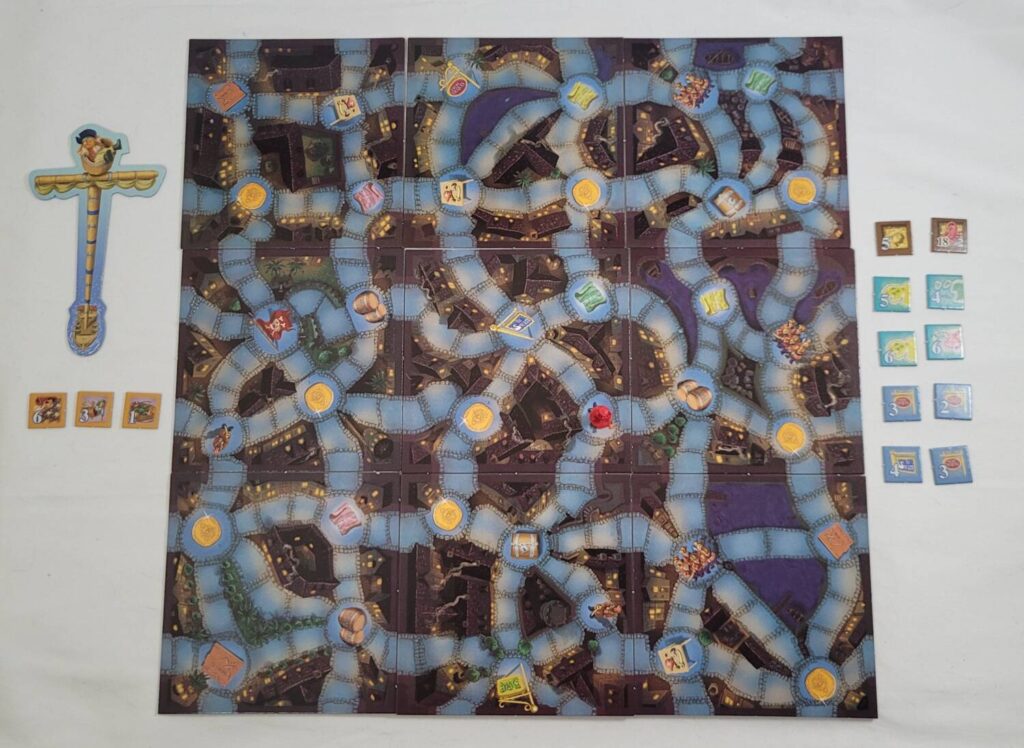
Next, each player chooses a color and receives two coins along with ten pirates and the flag of their chosen color. Their remaining five pirates are placed into a general supply. Finally, select a starting player, give them the starting player tile, and you’re ready to begin.
Shenanigans
The actual mechanics of taking a turn are easy: move Red Corsair (we’ll just call him Red from now on) down any open pathway to the next intersection and place one of your pirate figurines into each empty space he passes over. Then, perform the action associated with the space on which Red came to rest. If you don’t have enough pirate figurines to cover the spaces, then you can’t move Red down the path. If you can’t move Red at all due to not having enough pirate figurines, then you can either spend a coin to give up your turn or you can move your remaining figurines to the ship’s mast area (in which case you’re out for the remainder of the round). If you moved Red and performed the action, you can spend a coin to move him down a different path and take a different action, ad infinitum, until you opt to quit. If Red is ever unable to move due to every pathway from his position being clogged with drunken pirates, then he is moved to a different tile following some specific rules which I’m not going to get into here.
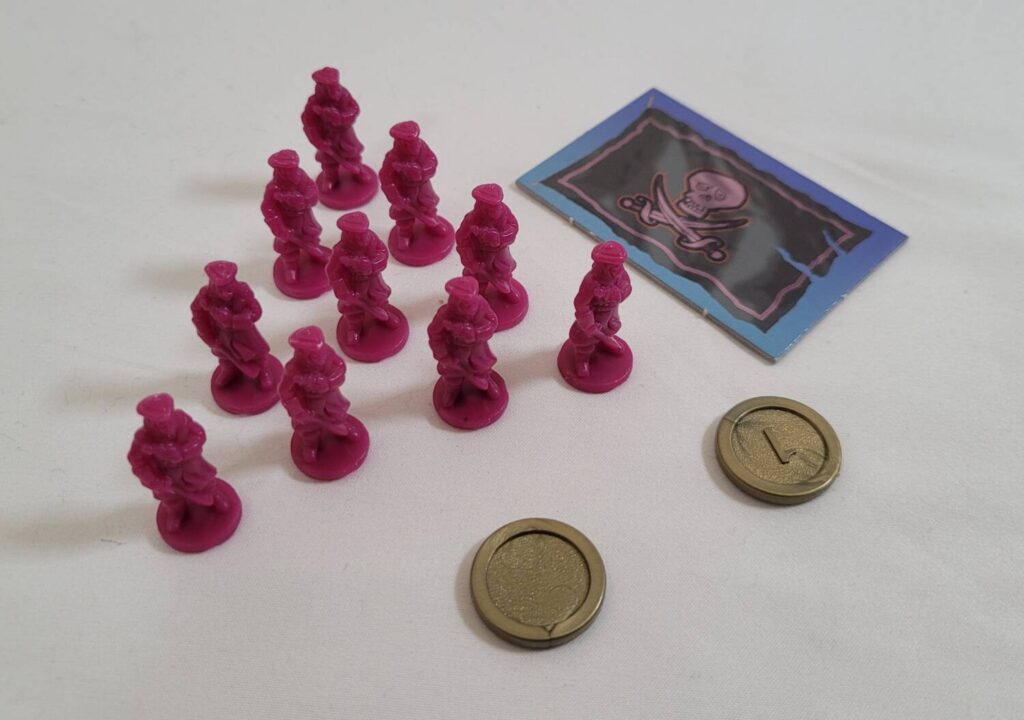
There are a total of ten different actions to choose from. Importantly, any tiles gained from the following actions are stored beneath your pirate flag, a detail which causes me some consternation. The actions are:
The coin and pirate actions gain you one extra coin or one extra pirate from the supply. The headquarters action allows you to reclaim one group of your previously placed pirates from the board. The rum barrel action space allows you to claim two rum barrels from the supply, which can be traded in later to re-roll dice. These are the four easiest actions. The other six require some more explanation.
Pirate supply: claim a random pirate supply token from the general supply. Then, you can either keep it or sell it for 2 coins. There are five different kinds you might receive, each with a different victory point value.
Rendezvous: claim a random rendezvous tile. Each of these tiles has a map location shown. If you manage to end one of your turns with Red at the location shown, reveal the tile and then add it to your score pile.
Treasure map: claim one of the face up treasure map tiles and replace it with a new one from the supply. Each tile has a value printed on it and represents half of a colored treasure map.
Guard: the player decides to take on either a small group or a large group of guards. Then, they reveal a tile of the appropriate type. If they have more pirates in their supply than the number on the tile, they win the fight and collect the tile. Otherwise, the tile is discarded to the bottom of the stack from whence it came.
Pub: the player who performs the action invites the other players to join them in a competition to acquire the pub tiles that match the color of the pub where the action was performed. Other players that want to join pay the active player a coin. Then, there is a roll off to determine the winners of the tile(s).
Treasure chest: the player who performs the action takes the regular treasure chest tile. Then, a roll off is performed to determine who winds up with the treasure chest with a scorpion tile. This tile is worth negative points at the end of the game, so the objective is to not win the roll off.
Sleeping Arrangements and Scoring
Once all players have completed their efforts on the map, a wrangle will be performed to fight for the berth positions. The pirate figurines are arranged on the left side of the ship’s mast in rows, by owner, and in columns. Then, working from the leftmost column and moving inward, the owner of each pirate in the column will participate in a roll off until only one pirate remains. That pirate is moved to the right of the ship’s mast. Then, a roll off is performed for each successive column until all of the columns have been considered.
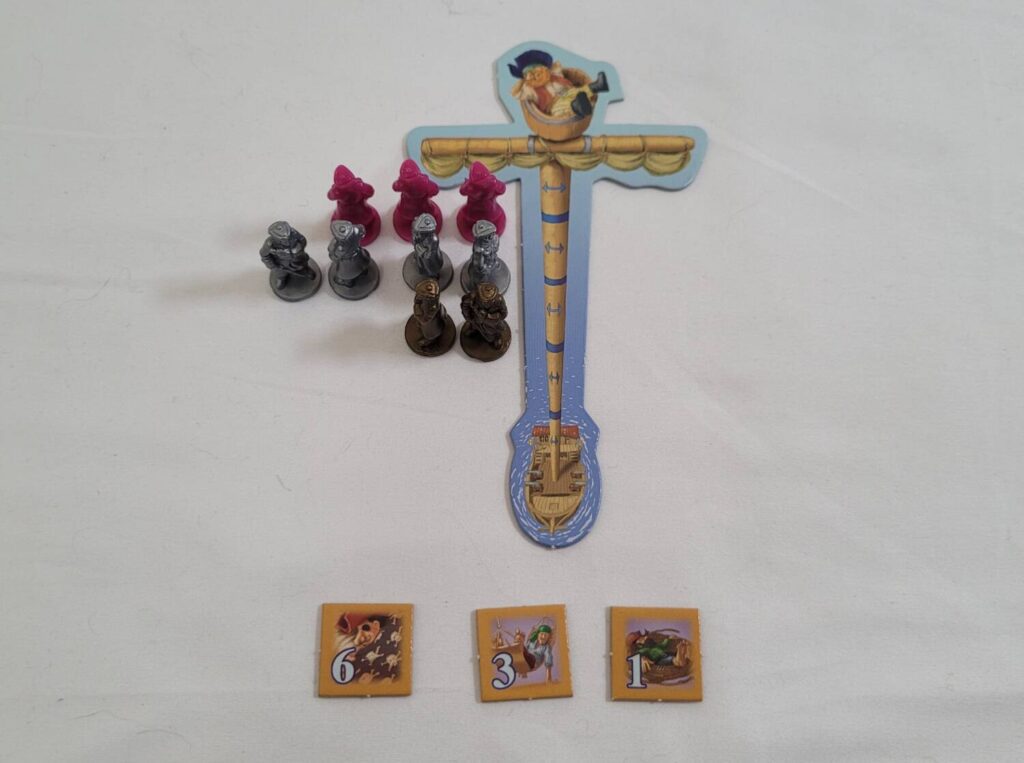
Next, a series of roll offs is performed for the right side of the ship’s mast with the winners being moved to the left side. This keeps going on, winning pirates moving from one side to another, with the losers being eliminated until a first, second, and third place emerge. First receives the bunk (the highest score), second receives the hammock (second highest score), and third receives the bedroll (the lowest scoring token).
After five such wrangles, the game ends and players tally their scores. Everything except for the maps are worth the amount printed on them. Maps only score their points as long as you have two matching colors. The player with the highest total wins.
Thoughts
I loathe wanton randomness in board games. I dislike knowing that all of your hard work and planning, everything you’ve gained or built, can all come to a swift and sudden end due to the roll of a die or the flip of a card. In this game, aside from deciding which path to send Red Corsair down or when to bow out, there are no decisions to make and there’s nothing, aside from cashing in a rum barrel for the chance at more randomness, that you can do to change your fate.
Rum & Pirates runs on randomness like America runs on Dunkin’ or cars run on gas. By all means, this should be a game that I hate, but it surprises me just how much I really enjoy it.
Thematically, the very act of being a pirate is risky business. Whether or not you’ll live to see the next day is a total crapshoot. It makes sense that a bunch of stumbling, drunken pirates would make bad decisions, gambling away their hard-earned booty without a second thought. In Rum & Pirates, the randomness makes sense, and I think that’s why I’m okay with it. In fact, I’m more than just okay with it. I love it. Rum & Pirates is loud, stupid, raucous fun.
The roll offs keep you invested, even when you’re not involved, trying to keep a running tally of what you think other people have. Because everyone’s tiles are hidden beneath their pirate flag, you can never be sure. And, of course, you’re even more invested when you’re one of the parties involved. The scorpion treasure is particularly inspired as you’ll actively root for someone else to win. And, while that is pretty clever, I think what is even more clever is the inclusion of the rendezvous tiles. When you’re able to move Red Corsair to the rendezvous it’s great, and can net you a lot of points. But, more often than not, Red Corsair’s going to be on the other side of the map from where you’d like him to be. So, you’ve got to try to figure out a way to trick your opponents into moving him into position for you. Easier said than done. It’s little things like this that hint at the designer Feld would one day become.
It’s an older design, but it still checks out.
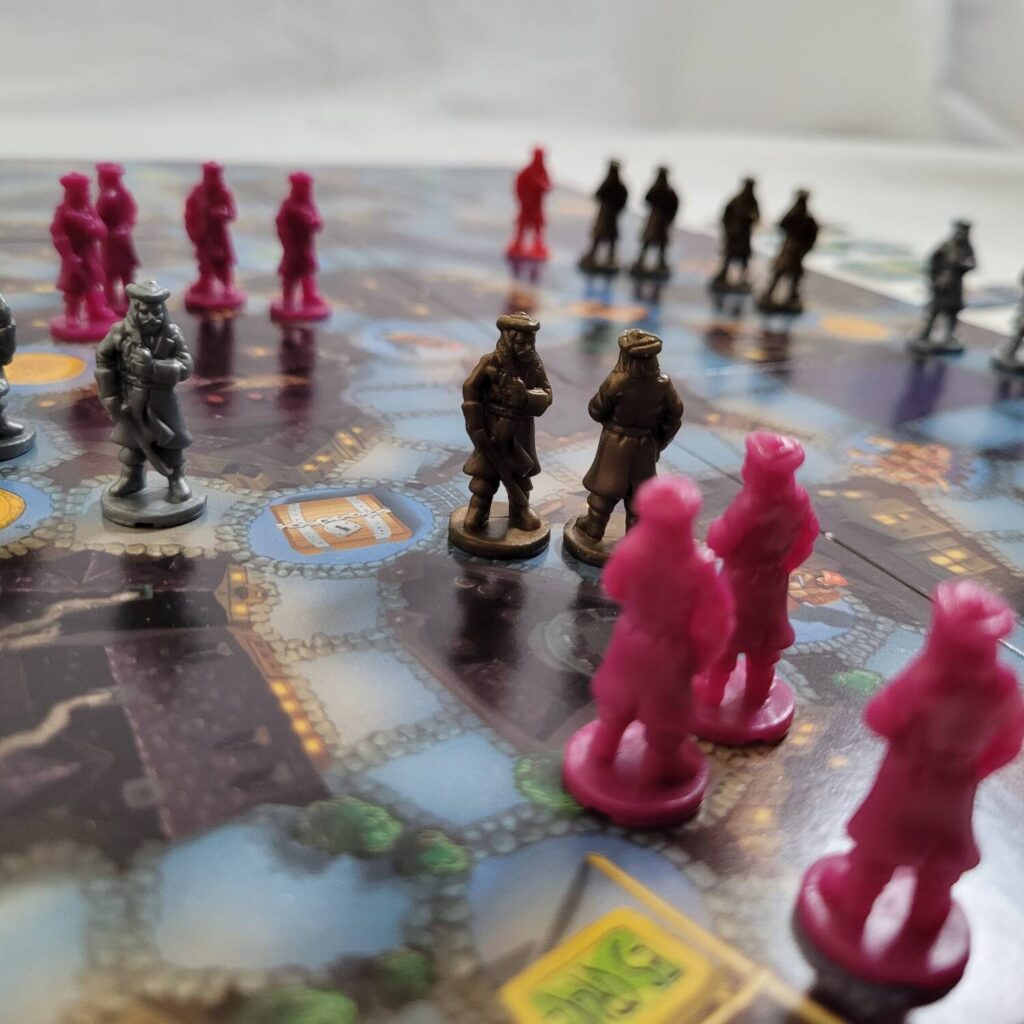
That being said, the game definitely shows its age both in terms of its mechanics as well as its production value. From the injection molded pirate figurines to the flimsy card stock on which the map tiles are printed, everything about the production of this game feels cheap. It’s like alea decided to take a flyer on Feld—who you will recall was still an up-and-coming designer at the time—but not too much of one. If a corner could be cut, they lopped it off. For instance, there are two plastic trays included in the box. One of these trays holds the various tiles, and it’s great. Each tile type has its own dedicated and labeled space and there’s a lid that fits snugly and holds it all in place. And, then there’s the second tray, the one that holds all of the plastic figurines and everything else. For some unknown reason, alea decided that one tray with a lid was enough. As a result, if you are ever unfortunate enough to accidentally turn this game on its side, you’re going to open the box to a godforsaken mess (assuming the weight of that same said mess doesn’t force the box open on its own).
The decision to have the players hide their booty underneath a cardboard flag is also one that has me scratching my head. The pirate flag is fine when you’ve only got one or two tiles to your name. But, when it starts getting up there into the 15+ range, the stack gets higher and higher and the whole thing becomes wobbly and unwieldy. Why not use a screen instead? Were player screens just not in vogue in the early aughts of the second millennium? Who knows.
What I do know is that despite its abundance of luck, despite the questionable production issues, despite the weatherred mechanics, Rum & Pirates is surprisingly fun and engaging. I’m glad it’s in my collection.


